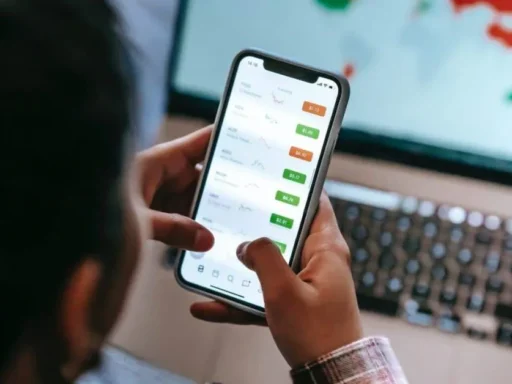
Imagine this: You’re sipping coffee at your favorite café, scrolling through your phone, when you overhear two friends talking about their investments. One mentions a stock that’s “skyrocketing,” while the other brags about their growing retirement fund. You think, “I’d love to invest, but I barely have enough to cover rent and groceries!” If this sounds familiar, you’re not alone. The good news? You don’t need a fortune to start investing. With as little as $5, you can dip your toes into the world of wealth-building. This guide will walk you through how to start investing with little money, offering practical steps, expert insights, and a sprinkle of storytelling to make the journey exciting and approachable.
Investing isn’t just for the wealthy—it’s for anyone with a vision for their financial future. Whether you’re a college student, a young professional, or someone juggling bills, this post will show you how to take control of your money, no matter how small the starting point. Let’s dive in and explore how to make your money work for you.
Why Investing with Little Money Matters
When I was in my early 20s, I thought investing was something reserved for people with six-figure salaries or trust funds. I was scraping by, working part-time as a barista, with maybe $50 left after bills each month. The idea of investing seemed laughable—until I learned that small, consistent steps could lead to big results. That’s the magic of compound interest, which Albert Einstein reportedly called the “eighth wonder of the world.” Even modest investments, when given time, can grow exponentially.
Investing with little money isn’t about getting rich quick; it’s about building a foundation for long-term financial security. According to the U.S. Securities and Exchange Commission (SEC), starting early, even with small amounts, can make a massive difference over decades. For example, investing just $10 a month at a 7% annual return could grow to over $5,000 in 20 years. That’s not life-changing money, but it’s a start—and it’s proof that small actions add up.
The barriers to entry have never been lower. Thanks to technology, micro-investing apps and low-cost platforms, anyone with a smartphone and a few bucks can become an investor. But where do you begin? Let’s break it down step by step.
Step 1: Get Your Financial House in Order
Before you invest a single dollar, take a hard look at your finances. Investing is exciting, but it’s not a race—it’s a marathon. My first attempt at investing was a disaster because I didn’t have an emergency fund. When my car broke down, I had to sell my tiny investment to cover repairs. Lesson learned: preparation is everything.
Here’s how to set yourself up for success:
- Create a Budget: Use a simple budgeting tool like YNAB (You Need A Budget) or a spreadsheet to track your income and expenses. Identify areas where you can cut back, like skipping that $5 latte a few times a month.
- Build an Emergency Fund: Aim to save at least $500–$1,000 in a high-yield savings account, such as one from Ally Bank, to cover unexpected expenses.
- Pay Down High-Interest Debt: Credit card debt with 20% interest will eat away at any investment gains. Focus on paying off high-interest debts first, using strategies like the debt snowball method.
- Set Clear Goals: Are you investing for retirement, a down payment on a house, or a dream vacation? Defining your goals will guide your investment choices.
By getting your financial house in order, you’re not just preparing to invest—you’re building a mindset of discipline and intentionality.
Step 2: Understand Your Investment Options
When you’re starting with little money, not all investments are created equal. Some require thousands of dollars upfront, while others let you start with pocket change. Here’s a rundown of beginner-friendly options that won’t break the bank:
Micro-Investing Apps
Apps like Acorns and Stash make investing as easy as ordering takeout. They round up your everyday purchases (like that $3.75 coffee) to the nearest dollar and invest the change. Over time, these small amounts add up. For example, Acorns lets you start with just $5, and you can choose portfolios tailored to your risk tolerance.
Fractional Shares
Gone are the days when you needed to buy a whole share of a stock. Platforms like Robinhood and Fidelity allow you to buy fractional shares of companies like Apple or Tesla for as little as $1. This means you can own a piece of your favorite companies without shelling out hundreds of dollars.
Exchange-Traded Funds (ETFs)
ETFs are baskets of stocks or bonds that trade like stocks on an exchange. They’re a great way to diversify your investments without needing a lot of cash. For instance, the Vanguard S&P 500 ETF (VOO) tracks the 500 largest U.S. companies and has a low expense ratio, making it ideal for beginners.
Retirement Accounts
If you’re thinking long-term, consider a Roth IRA. You can contribute up to $7,000 annually (as of 2025), and your investments grow tax-free. Many brokers, like Charles Schwab, have no minimum to open an account, so you can start with whatever you have.
High-Yield Savings Accounts
While not a traditional investment, high-yield savings accounts offer a safe place to grow your money with minimal risk. Platforms like Marcus by Goldman Sachs offer competitive interest rates, often above 4%, making them a solid starting point for risk-averse beginners.
Each option has its pros and cons, which we’ll compare in a table later. The key is to choose investments that align with your goals, risk tolerance, and budget.
Step 3: Start Small and Stay Consistent
When I first started investing, I committed to putting $10 a week into an ETF. It didn’t feel like much, but after a year, I had over $500 invested, plus some gains. Consistency is your superpower when you’re starting with little money. Here’s how to make it happen:
- Automate Your Investments: Set up automatic transfers to your investment account, even if it’s just $5 a week. Most platforms, like Acorns or Fidelity, make this easy.
- Use Dollar-Cost Averaging: Instead of trying to time the market, invest a fixed amount regularly. This strategy, explained by Morningstar, reduces the risk of buying at a peak price.
- Reinforce Small Wins: Celebrate milestones, like your first $100 invested. These small victories keep you motivated.
Consistency turns tiny investments into significant sums over time. Think of it like planting a seed—water it regularly, and it’ll grow into a sturdy tree.
Step 4: Educate Yourself Continuously
Investing can feel overwhelming, but knowledge is your best defense against costly mistakes. When I started, I fell for a “hot stock tip” from a friend and lost half my investment in a week. The lesson? Don’t invest in what you don’t understand. Here are some ways to build your investing know-how:
- Read Books: Classics like The Intelligent Investor by Benjamin Graham or A Random Walk Down Wall Street by Burton Malkiel offer timeless wisdom.
- Follow Reputable Sources: Websites like Investopedia and The Motley Fool break down complex topics in beginner-friendly ways.
- Join Communities: Online forums like Reddit’s r/personalfinance or X communities can provide real-world insights, but always verify advice with trusted sources.
- Take Free Courses: Platforms like Coursera offer free or low-cost courses on investing basics.
The more you learn, the more confident you’ll feel making informed decisions.
Comparison Table: Investment Options for Beginners
To help you choose the right path, here’s a comparison of popular investment options for those starting with little money:
| Investment Type | Minimum Investment | Risk Level | Best For | Key Benefit | Platform Example |
|---|---|---|---|---|---|
| Micro-Investing Apps | $5 | Low to Medium | Beginners | Easy automation | Acorns |
| Fractional Shares | $1 | Medium to High | Stock enthusiasts | Access to expensive stocks | Robinhood |
| ETFs | $10 | Medium | Diversification seekers | Low fees, broad exposure | Vanguard |
| Roth IRA | $0–$50 | Varies | Long-term planners | Tax-free growth | Charles Schwab |
| High-Yield Savings | $0 | Very Low | Risk-averse savers | Guaranteed returns | Marcus |
This table highlights how accessible investing has become. Whether you’re risk-averse or ready to dive into stocks, there’s an option for you.
Step 5: Avoid Common Pitfalls
Investing with little money comes with unique challenges. Here are some traps to avoid:
- Chasing Trends: Meme stocks and crypto hype can be tempting, but they’re often risky. Stick to diversified investments unless you’re prepared to lose your money.
- Ignoring Fees: Low-cost platforms are great, but watch out for hidden fees. For example, some apps charge monthly subscriptions that can eat into your returns.
- Emotional Investing: Markets fluctuate. Don’t panic-sell when your investments dip. Stay focused on your long-term goals.
- Overcomplicating Things: You don’t need to day-trade or analyze complex charts. Simple, consistent investments often outperform flashy strategies.
My biggest mistake was trying to “beat the market” with no experience. After losing $200 on a risky stock, I learned to stick to boring, reliable investments like ETFs. Slow and steady wins the race.
FAQ: Your Burning Questions Answered
How much money do I need to start investing?
You can start with as little as $1 on platforms like Robinhood or Acorns. The key is consistency—small, regular investments add up over time.
Is investing safe for beginners?
No investment is 100% safe, but options like ETFs and high-yield savings accounts are lower risk. Diversify your investments and only invest what you can afford to lose.
Should I invest all my money in one stock?
Never put all your eggs in one basket. Diversification, through ETFs or mutual funds, reduces risk by spreading your money across multiple assets.
How do I know which platform to use?
Choose a platform based on your goals and budget. For simplicity, try Acorns or Stash. For more control, consider Fidelity or Charles Schwab.
What if the market crashes?
Market downturns are normal. If you’re investing for the long term, hold steady and keep investing. Historically, markets recover over time.
Can I invest without a lot of time to manage it?
Yes! Micro-investing apps and automated Roth IRA contributions require minimal effort. Set it and forget it, but check in periodically.
Conclusion: Your Journey Starts Now
Investing with little money isn’t about instant riches—it’s about taking control of your financial future, one small step at a time. When I started investing my $10 a week, I felt like I was shouting into the void. But over time, those tiny contributions grew into a nest egg that gave me confidence and options. Whether you’re investing $5 or $500, the principles are the same: start small, stay consistent, and keep learning.
The world of investing can feel intimidating, but it’s more accessible than ever. With tools like micro-investing apps, fractional shares, and low-cost ETFs, you don’t need a fat wallet to build wealth. Set clear goals, educate yourself, and avoid common pitfalls. Most importantly, start today. Even a single dollar invested now is a step toward financial freedom.
What’s your next step? Download an app like Acorns or open a Roth IRA with Fidelity. Set up a small, automatic investment and watch your money grow. Share your progress with friends or on X to stay motivated. The journey to financial independence is yours to take—start now, and future you will thank you.


